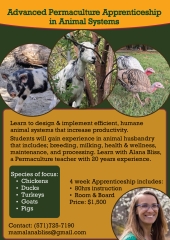"Biodynamic farming involves managing a farm utilizing the principles of a living organism.
A concise model of a living organism ideal would be a wilderness forest.
In such a system there is a high degree of self-sufficiency in all realms of biological survival.
Fertility and feed arise out of the recycling of the organic material the system generates.
Avoidance of pest species is based on biological vigor and its intrinsic biological and genetic diversity.
Water is efficiently cycled through the system."
" In day-to-day practice the goal is to create a farm system that is minimally dependent on imported materials, and instead meets its needs from the living dynamics of the farm itself.
It is the biodiversity of the farm, organized so that the waste of one part of the farm becomes the energy for another, that results in an increase in the farm’s capacity for self-renewal and ultimately makes the farm sustainable."
"This requires that, as much as possible, a farm be regenerative rather than degenerative.
Consider carefully materials that are imported onto the modern day organic farm.
Where do they come from? Often they can be tracked back to a natural resource provided by the earth.
Examples include petroleum to move materials around, ancient mineral deposits, by-products of unsustainable agriculture-related industry, and the life of the seas and waterways.
An important social value of Biodynamic farming is that it does not depend on the mining of the earth’s natural resource base but instead emphasizes contributing to it. "
Those are the basis of Biodynamics. Quoted from Demeter Association Inc.
Sheet mulching will indeed fit within the parameters of biodynamic practices and should be used everywhere you have a need to utilize on site materials for control of what grows where and to protect moisture from evaporation.
it will build soil as fast as any other method.
biodynamics
Biodynamics also fit within the ideals and practices of permaculture methodology.







